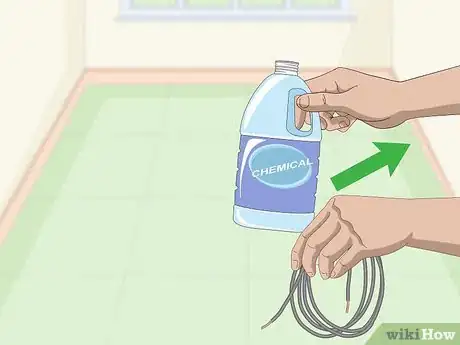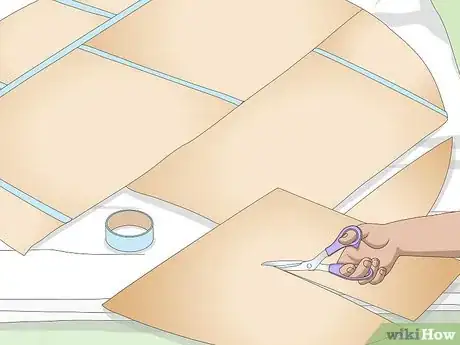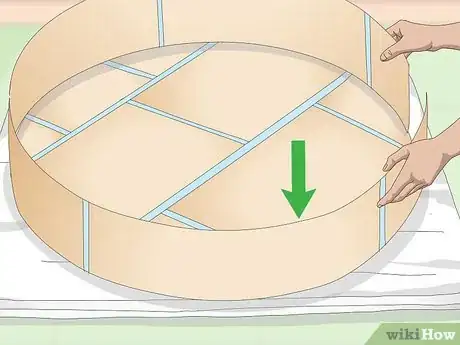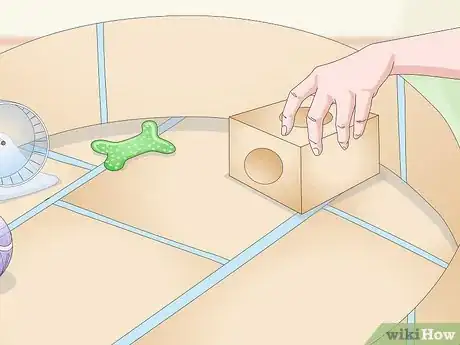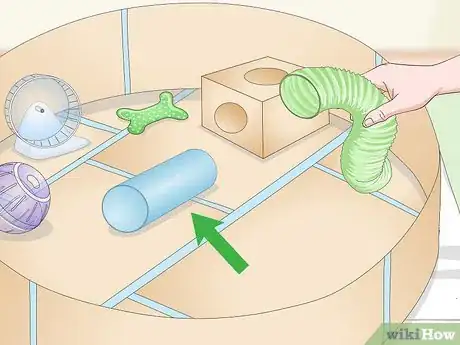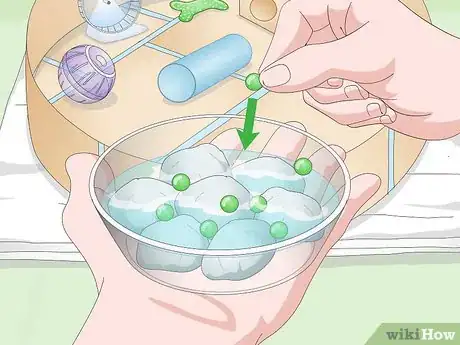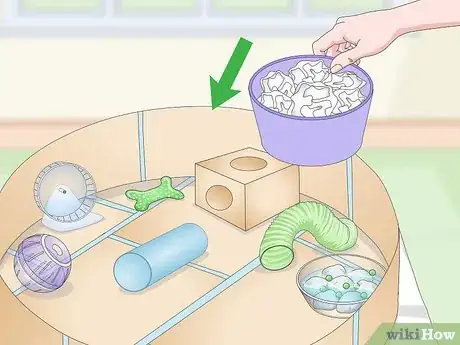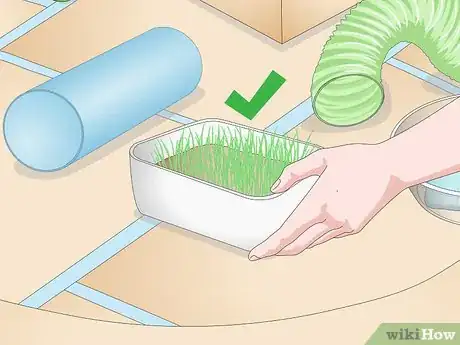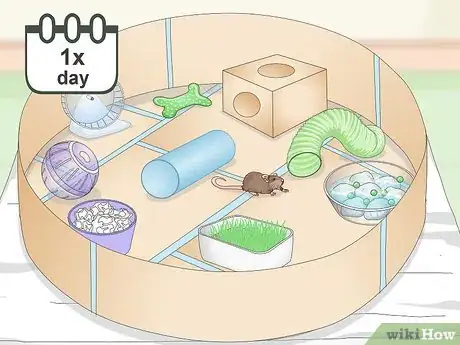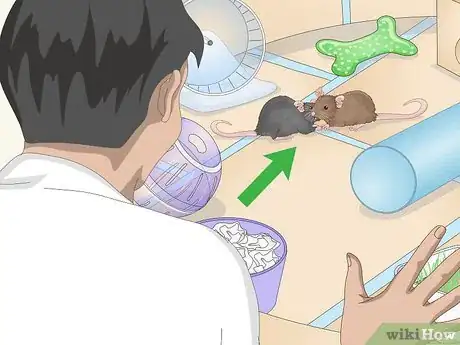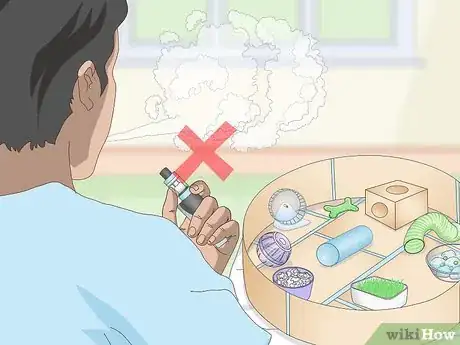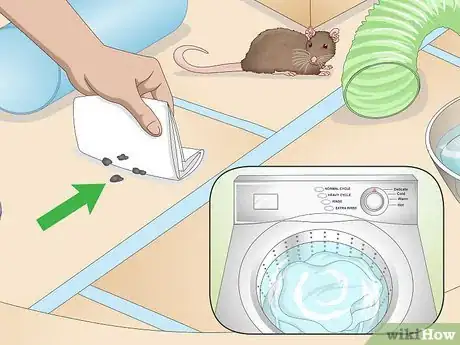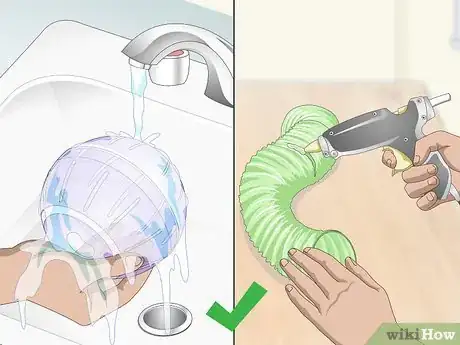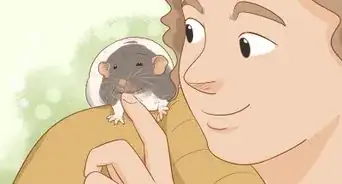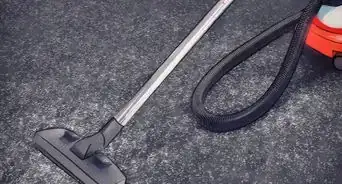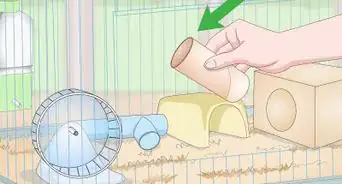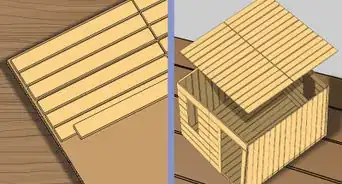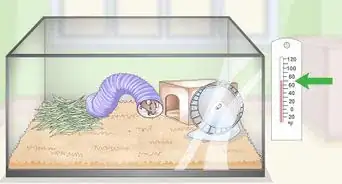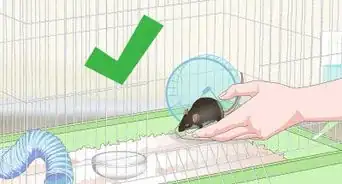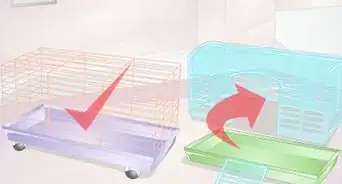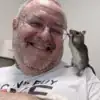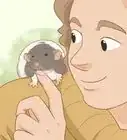This article was co-authored by Brian Starr. Brian Starr is a Rat Specialist and Breeder and the Owner of OC Dumbos out of Central Florida. As America’s only breeder of pet Roof Rats, Brian and OC Dumbos specialize in rat breeding, training, and care. Years of experience and several generations of careful breeding have allowed Brian and OC Dumbos to create a line of tame Roof Rats, bred to make friendly, fun pets. In addition to offering rat accessories and training resources, OC Dumbos also offers free Roof Rat adoptions.
There are 7 references cited in this article, which can be found at the bottom of the page.
wikiHow marks an article as reader-approved once it receives enough positive feedback. In this case, 100% of readers who voted found the article helpful, earning it our reader-approved status.
This article has been viewed 91,191 times.
Rats need a lot of exercise and space to roam. Unlike small rodents like mice and hamsters, they can't spend most of their life in a cage. Some owners let their rats run freely in the home, but if your home hasn't been rat proofed it's usually a bad idea. Making a safe rat play area, on the other hand, is the best option for entertaining your rats without damaging your property.
Steps
Setting up a Closed-Off Area
-
1Clear the area of anything that could harm your rats. While the play area will be surrounded by a barrier, bright lights, and low heater vents, make sure to keep electric wires out of the way. Electric wires can hurt your rat. Clear the area of chemicals, wires, sharp objects, and anything that emits smoke (like a candle).[1] Choose a location away from foot traffic and other animals.
- The best place to keep a rat play area is in the corner of a living room or on a hardwood floor. Just keep the play area away from things you don't want chewed up and away from outlets.
-
2Place a blanket or tarp over a flat surface to protect it from damage. It's best to plan a play area on a raised surface, but you can set one up on the floor if you don't have space. Rats instinctively like to chew things up, so protect your floor or table with a plastic tarp or blanket before you add anything else.[2] Plus, if they relieve themselves in the area, you just have to wash the tarp or blanket rather than break out the cleaning spray.
- If you put the playground on a table, you may not need to put up a fence around the play area, as rats won't jump off a height that will hurt them. Use your own judgement and knowledge of your rats' behaviour to decide whether to keep it free-range or build a barrier.
- Keeping the play area on the floor allows you to keep a better eye on the rats, though they may chew your carpet if they get through the blanket or tarp.
Advertisement -
3Cut out and tape together flat, equal-sized cardboard panels. Take a few boxes, lay them flat, and cut away each side until you have at least a few dozen equal-sized pieces. Use duct tape to close holes and to flatten pieces that fold down so each panel is completely flattened.[3] Line up the panels side by side and duct tape the edges to form a single long, flexible barrier.
- It's best to make your rat play area 4–6 ft (1.2–1.8 m) wide in all directions, so make the barrier long enough to encapsulate this area when you set it up on the tarp.
- Fold the pieces one by one to form an accordion-like shape. This allows for easy storage of the cardboard barrier, which can be reused over and over again.
- Use cardboard pieces at least 2 feet (0.61 m) tall to prevent your rats from jumping out. Use taller pieces if your rats are particularly agile.
-
4Place the cardboard barrier around your chosen area in a circle. Making sure to keep the barrier on the blanket or tarp, surround the area with the cardboard in a circle shape until the two ends meet. Connect the two ends with binder clips, and check again for any holes the rats could sneak through.[4] Tape up these holes and you're ready to start adding toys and playthings.
- Using binder clips to secure the ends together rather than tape makes this barrier reusable. Simply remove the binder clips when the rats are done, and fold the barrier into an accordion-like shape again.
- If your cardboard barrier is too large to stay within the confines of the tarp or blanket, cut away a panel at a time until it surrounds the area without any of the underlying surface peeking through.
Adding Toys and Accessories
-
1Use only toys and accessories with no sharp edges or moving parts. Rats like to play with just about everything, but avoid providing these types of toys or your rat could get itself caught and seriously hurt itself. Rats like to drag their tails behind them, so it could get caught in a battery-powered toy or on a sharp piece of metal. Opt for soft, rounded toys instead.[5]
- A rat wheel is one of the few exceptions to this. As long as the inside panel is completely covered, the rat shouldn't get its tail stuck in any moving parts. Buy a wheel specially made for rats, as mouse and hamster wheels are just too small for them to use.
-
2Build a cardboard "rat fort" inside the play area. Cut out some rat-sized holes in a few small boxes, such as shoe boxes, and arrange them on top of each other randomly to create a tall structure for your rats to explore. Cut some holes in the tops of the boxes too so your rats can crawl around inside the fort. Arrange other accessories as you see fit, like small pieces of fabric to create curtains, or strips of cardboard to make ladders.
- Add treats wrapped in paper to the inside of the fort, which entices your rats into exploring for hidden treasure!
-
3Add some PVC pipe or fabric tunnels for your rat to crawl through. PVC pipe is perfect for creating elaborate mazes for your rats. Go to your local hardware store for a variety of at least 2.5 in (6.4 cm) wide PVC pipes. Connect angled pipes, straight pipes, and pipe connectors together in random arrangements to create a tunnel maze. You can also make fabric tunnels by cutting the legs or sleeves of old clothes and stuffing them with toilet paper tubes.
- PVC pipe is better for rats who like to chew a lot, whereas a fabric tunnel lets you keep an eye on where your rat is at in the maze.
- Simply disconnect the PVC pipes from each other when you are ready to take down the rat play area — you can create a different maze pattern next time you let the rats out!
-
4Create a pea fishing pond with a shallow dish and rocks. Fill a shallow dish, no more than 1 in (2.5 cm) deep, halfway with water. Place some rocks big enough to poke out of the water, and add some frozen peas. Your water-loving rats will love the chance to get wet and get a snack at the same time, while your water-fearing rats can safely stand on a rock or on the edge and grab peas that float by!
- A paint tray meant for paint rollers is great for this, as it has a deep end and a shallow end. Your rats can stand on one side and fish, or go for a dip in the deeper end.
-
5Add a small bin of trash for your rats to root around in. Fill a small garbage basket, one that you would keep under a desk, with crumpled paper, toilet paper rolls, extra pieces of cardboard, and other soft, safe materials for your rat to dig through.[6] Rats love crunchy noises and collecting bits of trash for themselves, so use a variety of materials to entertain your rat.
- Root through your own trash and recycling bin for small objects that are safe for your rat if you want to conserve resources.[7]
- Don't add any discarded food or organic products, as if they have gone bad your rat might get sick. If you want to add food to the bin, add some rat snacks at the bottom before filling it with trash, as this entices your rats to dig in deeper.
-
6Create a digging pit with a plastic container, dirt, and veggie sprouts. Fill a square plastic container halfway with regular, clean soil, then plant sprout seeds, wheat seeds, and grass seeds. Water the soil until its slightly saturated each day for about a week. When the sprouts start to show, let your rats dig around and munch on the greenery!
- Rats can eat just about anything, but avoid planting poppy seeds in the digging pit. It's been shown that poppies can kill rats.[8]
- If you'd rather not wait for a week as the sprouts grow, simply bury some of your rats' favorite treats under the dirt and let them dig them out. Be sure to use clean soil, which you can buy at any gardening store.
- Rats also love chewing plants in general, so if you have plants that are dying and you plan to throw them out anyway, let your rats have some fun with them first!
Playing with Your Rats Safely
-
1Let your rats out for free-range play time at least once a day. Rats need exercise and free roam time to prevent boredom and cabin fever. Rats that don't get let out tend to become territorial, aggressive towards people, and shy. Let your rats out at least once a day in their play area for at least an hour. If you have the time, let them out more often for longer, and don't forget to interact with them when they're out![9]
- Rats are extremely social animals and will feel cramped and bored if they stay in their cage with no interaction. Even if you have a few rats, the cage simply isn't enough space for them to roam and be curious.
- Handle your rats with care, as mishandled rats can start to distrust people and may become aggressive. Never squeeze or throw your rats, only hold them in your palm or let them walk on your arms.
-
2Keep an eye on the rats as they play to watch for escapes and fights. Rats are very quick and very nimble, so even if you think the cardboard barrier is tall enough, a rat can jump it if desperate enough. Rats also fight quite often, but break up fights that get particularly vicious. Never leave the room your rats are playing in or you won't be able to prevent them from escaping, fighting, or chewing things they shouldn't.[10]
- When play fighting, rats will squeak and tumble around, but when really fighting, their fur raises and they scream a lot louder and a lot more often, usually while wrestling quite viciously. Break up fights that seem too rough, but let your rats play if they aren't actively scratching or biting each other.
- Check your rats for scratches and bites if the fight got too intense. Keep the rats separated until they've both calmed down if one has been hurt. For particularly bad injuries, contact your vet for help.[11]
-
3Avoid smoking or vaping in the same room as the rats. Rats are incredibly prone to respiratory issues — in fact, it's the number one cause of rat deaths. Do not smoke or vape in the same room as your rats ever, and turn off oil diffusers and put out candles in the same room as well.[12]
- Use dust-free lining for the cage and clean it at least once a week to further prevent respiratory issues.
-
4Clean up messes as soon as they occur, and wash the blanket or tarp between uses. If you see your rat pee or poop in the play area, wipe it or pick it up with a dry paper towel and discard it. Clean the underlying tarp or blanket between uses to minimize the risk of getting your rats sick or stinking up the play area.
- If the blanket or tarp doesn't smell or has no stains, it's usually fine to use at least one more time before a wash. Always wash and clean your tarp or blanket if your rats relieved themselves on it.
-
5Wash and repair toys as the rats dirty and damage them. Rinse non-cardboard toys under water, wash fabric tunnels at least once a week, and replace cardboard boxes as they start to smell and get chewed up. This ensures that your rats' play area is fresh and clean every time, and reduces the chance of getting respiratory issues or diseases.[13]
- If the barrier itself becomes damaged, try duct tape to cover holes first, but you may need to remove damaged panels and re-attach new ones if the holes are unfixable.
Expert Q&A
-
QuestionHow can I make an easy play area for arboreal rats?
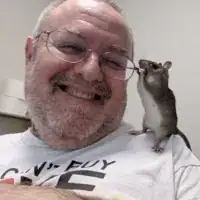 Brian StarrBrian Starr is a Rat Specialist and Breeder and the Owner of OC Dumbos out of Central Florida. As America’s only breeder of pet Roof Rats, Brian and OC Dumbos specialize in rat breeding, training, and care. Years of experience and several generations of careful breeding have allowed Brian and OC Dumbos to create a line of tame Roof Rats, bred to make friendly, fun pets. In addition to offering rat accessories and training resources, OC Dumbos also offers free Roof Rat adoptions.
Brian StarrBrian Starr is a Rat Specialist and Breeder and the Owner of OC Dumbos out of Central Florida. As America’s only breeder of pet Roof Rats, Brian and OC Dumbos specialize in rat breeding, training, and care. Years of experience and several generations of careful breeding have allowed Brian and OC Dumbos to create a line of tame Roof Rats, bred to make friendly, fun pets. In addition to offering rat accessories and training resources, OC Dumbos also offers free Roof Rat adoptions.
Rat Specialist & Breeder Arboreal rats like to climb and jump, so you can give them a cat tree or something similar to play on.
Arboreal rats like to climb and jump, so you can give them a cat tree or something similar to play on. -
QuestionWhat if I have a blind rat, how will she get around?
 Community AnswerRats actually don't need their eyes as much as most people think. They are very good at using their other senses to get around. I would recommend a small fence or boundary around the table, and keeping an eye on your rat at all times. Other than that, she should be fine! Just don't make very tall play houses that she could fall off.
Community AnswerRats actually don't need their eyes as much as most people think. They are very good at using their other senses to get around. I would recommend a small fence or boundary around the table, and keeping an eye on your rat at all times. Other than that, she should be fine! Just don't make very tall play houses that she could fall off. -
QuestionWhat if I have two rats that are skittish and won't let me hold them?
 Community AnswerGive them time. See if they will crawl into a hoodie pocket. You could also try setting your hand down and see if they will investigate, if they do, it's a good sign. If they wont investigate, try offering treats.
Community AnswerGive them time. See if they will crawl into a hoodie pocket. You could also try setting your hand down and see if they will investigate, if they do, it's a good sign. If they wont investigate, try offering treats.
Warnings
- When selecting garbage to reuse as rat toys, cut up anything they could get their feet or head stuck in.⧼thumbs_response⧽
- Always check your materials for sharp objects or hazardous parts.⧼thumbs_response⧽
- NEVER use a run-around ball for a rat. It can permanently damage their spine!⧼thumbs_response⧽
Things You'll Need
Setting Up a Closed-Off Area
- Duct tape
- Medium-large cardboard boxes
- Scissors or an X-ACTO knife
Adding Toys and Accessories
- Small cardboard boxes
- PVC pipes or fabric tubes
- Garbage basket
- Shallow dish or paint roller tray
- Rocks
- Clean soil
- Various vegetable seeds
- Plastic container
References
- ↑ https://www.bluecross.org.uk/pet-advice/caring-your-rat
- ↑ https://serribrat.wordpress.com/2014/07/15/tutorial-play-area-for-pet-rats/
- ↑ https://youtu.be/gWOy8_pYr10?t=69
- ↑ https://youtu.be/gWOy8_pYr10?t=282
- ↑ https://www.bluecross.org.uk/pet-advice/caring-your-rat
- ↑ http://www.afrma.org/pp_playpen.htm
- ↑ https://pethelpful.com/rodents/Rat-Nutritional-Information-Can-my-Pet-Rat-Eat-This
- ↑ https://pethelpful.com/rodents/Rat-Nutritional-Information-Can-my-Pet-Rat-Eat-This
- ↑ https://www.bluecross.org.uk/pet-advice/caring-your-rat
About This Article
To build a safe playground for your pet rats, start by cutting a few dozen equally-sized panels out of cardboard boxes and taping the edges of the panels together. Then, lay a blanket down on a flat surface, and stand the chain of cardboard panels up on its side in a circle to create a barrier so your rats can't get out. Finally, fill the closed-off area with fun toys and accessories for your rats, like tubes, a plastic container filled with dirt, and a cardboard fort. To learn how to safely play with your pet rats in their new playground, scroll down!
